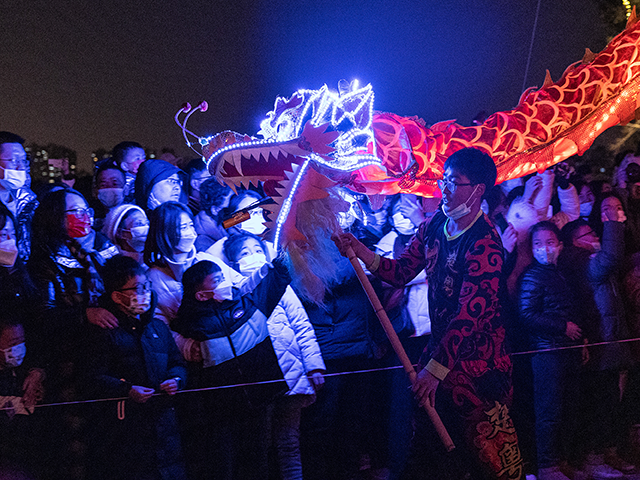Chinese officials claimed on Thursday that coronavirus fatalities have dropped by almost 80 percent since the beginning of January, indicating the vast wave of infections sweeping the country is quickly coming to an end.
China’s state-run Global Times on Wednesday boasted of a “joyful, bustling Chinese New Year” in the city of Wuhan – Ground Zero for the worldwide pandemic – thanks to China’s “proactive [Chinese coronavirus] optimization.”
The Global Times boasted that China supposedly defeated the original Chinese coronavirus outbreak with strict lockdowns, and now Wuhan was celebrating a second victory over the Omicron variant achieved with “optimized” policies:
Hundreds of thousands of people lined up on Monday morning outside the Yellow Crane Tower, the city’s iconic landmark that was temporarily closed during the Chinese New Year in 2020 as part of the city’s epidemic prevention and control measures. In the east square of the Yellow Crane Tower, some of classic plays of Han Show, referring to elegant Chinese traditional culture presented in the creative and thrilling form of live performance, were staged, and from the Chinese New Year’s Eve, about 60 percent of the visitors to the tower were from outside Wuhan.
The joyful hustle and bustle in 2023 strikes a sharp contrast from the images of empty and quiet streets during the Spring Festival three years ago, which also became a reminder for local residents about how hard Chinese people have been fighting the epidemic with confidence and solidarity.
A 34-year-old local resident surnamed Wang said the festival atmosphere was palpable in shopping malls with red lanterns, decorations and joyful background music. “In cinema, we can finally enjoy the movie with popcorns and milk tea, like we did before the epidemic started,” she told the Global Times on Wednesday.
“Optimization” is the Chinese Communist Party’s euphemism for the extremely sudden abandonment of not only city-wrecking lockdowns, but virtually all pandemic precautions, in December. Issued after weeks of nationwide anti-lockdown protests, the new “optimized” procedures discarded all control measures without giving doctors any time to prepare for the subsequent deluge of infections.
The resulting explosion of coronavirus cases swamped hospitals and funeral homes across the country, although the Chinese government stubbornly insisted virtually no one was actually dying until the World Health Organization (W.H.O.) hounded it into releasing some data on infections and fatalities in mid-January.
China faced worldwide criticism for abandoning travel restrictions to facilitate the busy Lunar New Year travel season, during the worst outbreak of the pandemic. Many other countries imposed testing requirements and other restrictions on Chinese travelers, including the United States. Beijing angrily denounced these measures as “unreasonable” and “anti-scientific.”
“I feel that people are relaxed, really enjoying the holidays, as we also see the first wave of infection passed since the country optimized its [coronavirus] measures,” a Wuhan resident told the Global Times, echoing the official government line that the omicron surge of December is coming to an end.
China’s Center for Disease Control and Prevention (CDC) said last week that roughly 73,000 people died from coronavirus-related illness during the previous month, a figure regarded as a deceptive understatement by outside observers.
The CDC said there were only 896 coronavirus deaths in Chinese hospitals on Monday, a 79-percent decrease from the daily totals in the first week of January. 36,000 people were supposedly hospitalized due to Chinese coronavirus on Monday, a 72-percent drop from the peak this month.
The BBC on Wednesday saw considerable evidence to doubt China’s claims of rapidly declining fatalities, such as rural coffin-makers working around the clock to meet the demand for caskets and funeral home workers cracking dark jokes about how rich they are getting.
“Some sick people are already very weak. Then they catch [coronavirus], and their elderly bodies can’t handle it,” explained a busy caterer as he loaded his truck to scoot from one funeral to the next.
The pro-communist New York Times (NYT) on Thursday reported Chinese Communist officials are still quietly rounding up people who participated in the anti-lockdown protests of late November:
The party seems determined to warn off anyone who may have been emboldened by the remarkable outburst of public discontent, which was followed just days later by Beijing’s abrupt decision to abandon Covid restrictions. Since then, domestic challenges have mounted: Youth unemployment is high, the economy is slowing, and Covid infections and deaths have accelerated.
The authorities have not officially announced the arrests and have largely avoided even acknowledging the protests. In seeking to tamp down unrest without further inflaming public anger, the party has often favored discreet repression.
But news about the arrests — as well as the interrogations and detentions of many other protesters — has circulated widely among those who attended the demonstrations, or who cheered them on as hope for a rebirth of civil society. For many, the crackdown is a fresh reminder of the authorities’ intolerance for even peaceful dissent, and of the personal risks that come with testing Beijing.
A Chinese activist told the NYT that Communist Party officials wish to shore up their narrative that hostile foreign powers like the United States organized the anti-lockdown protests, so they are pouncing on protest attendees who have any connection to other “subversive” political movements, such as feminism.
“The Chinese government has to look for an explanation that fits their logic, and they don’t believe that people organize on their own, according to their own political feeling. There must be a ‘black hand.’ In China, feminism is the last active, visible social movement,” she explained.

COMMENTS
Please let us know if you're having issues with commenting.